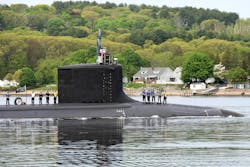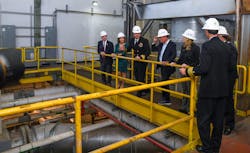New Microgrid Provides Resilience to U.S. Navy Submarine Base in Connecticut
As part of the U.S. military’s Energy Action Month, Naval Submarine Base New London (SUBASE) recently celebrated the launch of a new cybersecure microgrid that can fully power the base in case of a grid outage.
The microgrid was built under an energy savings performance contract (ESPC) with NORESCO, a Massachusetts-based intelligent climate and energy solutions provider.
The state of Connecticut, the Connecticut Municipal Electric Energy Cooperative (CMEEC), FuelCell Energy and Groton Utilities also participated in the construction of the base’s new microgrid.
As part of the microgrid, CMEEC and FuelCell Energy, a Connecticut-based energy solutions provider, built a 7.4-MW natural gas-fired fuel cell park on land leased from the base. The base has first right to the on-site power generated by the fuel cell park in the event of a grid interruption.
The microgrid is also connected to a 10.75-MW combined heat and power (CHP) system installed by NORESCO under the same ESPC. The CHP system includes two new generators and high efficiency boilers.
NORESCO also provided the cybersecure microgrid controls that will enable fast load shedding and for the base’s power plant to “island” from the grid in case of an outage.
In island mode, the microgrid disconnects from the grid and draws power from on-site power sources Once grid power is restored, the controller seamlessly reconnects to the grid.
“Our microgrid at SUBASE is the first of its kind in the entire Navy to support such a complex electrical infrastructure,” said Captain Kenneth Curtin Jr., the Commanding Officer of Naval Submarine Base New London.
It is expected that the improvements will deliver more than $183 million in energy and operational savings over the 18-year contract.
Back from the brink
Located on the banks of the Thames River in Groton, Conn., Naval Submarine Base New London was the U.S. Navy’s first submarine base. Dubbed the Navy’s “First and Finest Submarine Base,” SUBASE is home to the Naval submarine school, a submarine medical research laboratory and approximately 6,500 military personnel and their families.
With more than 1,000 civilian employees, the base is also one of the largest employers in the region.
SUBASE has twice found itself on the brink of closure thanks to decisions made by the Base Realignment and Closure Commission. To ensure its longevity, officials sought to shore up one of its biggest vulnerabilities – its reliance on the outside power grid.
The microgrid, which can fully power the base during a grid outage, eliminates that weakness.
“Whether it is a weather event or a bad actor, the lights will stay on at our Navy base,” said Ned Lamont, governor of Connecticut.
Energy efficiency improvements also improve resilience
The Navy has taken other steps to ensure the installation has the energy reliability, security and resilience necessary to support its critical mission.
Recent energy conservation measures include upgrades to modernize the base’s electrical infrastructure and steam distribution systems, conversion to LED lighting and the installation of a base-wide cybersecure energy management control system. All told, more than $235 million has been invested in SUBASE’s energy infrastructure.
“Today exemplifies our commitment to positively impacting SUBASE’s Fleet, Fighters, and Families through the best infrastructure and service support we can deliver,” Curtain said at the microgrid’s ribbon cutting ceremony in late October.
About the Author
Kathy Hitchens
Special Projects Editor
I work as a writer and special projects editor for Microgrid Knowledge. I have over 30 years of writing experience, working with a variety of companies in the renewable energy, electric vehicle and utility sector, as well as those in the entertainment, education, and financial industries. I have a BFA in Media Arts from the University of Arizona and a MBA from the University of Denver.


